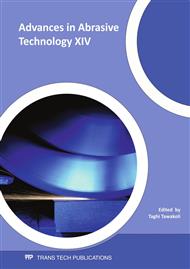p.103
p.110
p.116
p.122
p.128
p.134
p.140
p.147
p.153
FEM Analysis of Single Grit Chip Formation in Creep-Feed Grinding of Inconel 718 Superalloy
Abstract:
Recent advances in materials science have necessitated the development and understanding of manufacturing processes for safe and repeatable utilization. Grinding is shown to be a promising material removal process especially for brittle and hard to cut materials such as superalloys. Grinding has always been associated with analysis and modeling complications regarding its nature which has limited its extension and reliability of use. The first step in analysis of grinding is considering the action of a single abrasive grit on workpiece surface. In this work the action of a single CBN abrasive grit in creep-feed grinding process of Inconel 718 superalloy is modeled and analyzed using a 3D FEM software, DEFORM. Thermal and mechanical characteristics of the mutual interaction between grit and workpiece surface, and different chip formation phases are defined which can further be used to analyze the whole process.
Info:
Periodical:
Pages:
128-133
Citation:
Online since:
August 2011
Authors:
Price:
Сopyright:
© 2011 Trans Tech Publications Ltd. All Rights Reserved
Share:
Citation:


